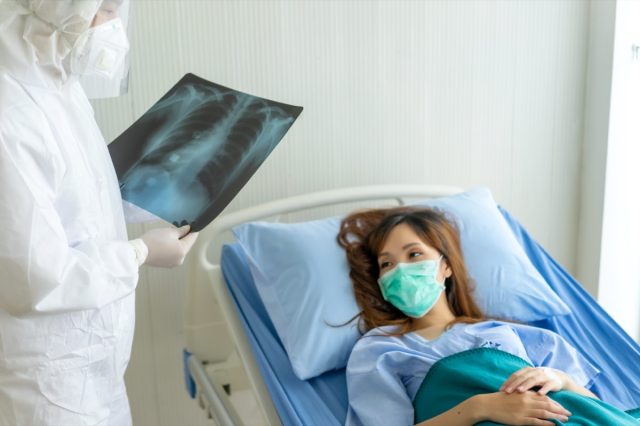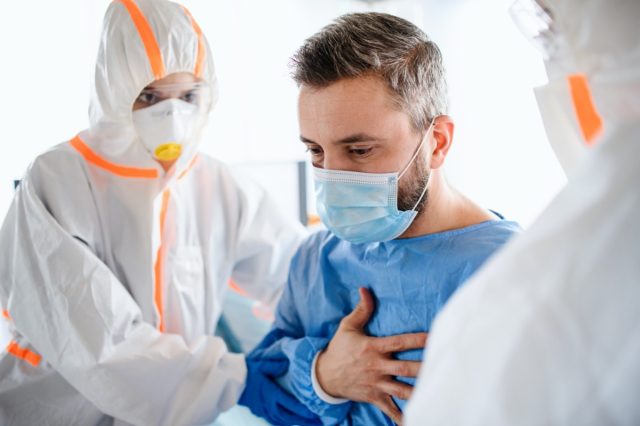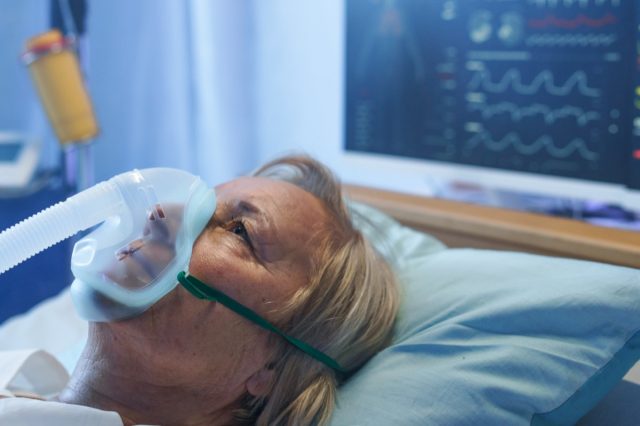Warning Signs COVID is in Your Lungs Now — Eat This Not That - Eat This, Not That
BA.5, a subvariant of omicron continues to dominate the wave of summer cases and cause an uptick in infection rates across the United States. The latest strain was discovered in April and is the most contagious mutation yet. In addition, COVID is causing lung issues in many patients and Eat This, Not That! Heath spoke with experts who explain warning signs COVID is in your lungs and what to know about BA.5. Read on—and to ensure your health and the health of others, don't miss these Sure Signs You've Already Had COVID.

Dr. Tom Yadegar, pulmonologist and medical director of the intensive care unit at Providence Cedars-Sinai Tarzana Medical Center says, "Because COVID-19 is spread via respiratory droplets, one of the first locations the virus infects is the respiratory tract. From here, the cells of the respiratory tract can become inflamed and allow the infection to settle within the respiratory tract. Depending upon the risk profile of the patient, which can include genetics, age, smoking status and pre-existing lung conditions, a COVID-19 infection can range from a simple bronchitis to pneumonia to full-blown respiratory distress."
Dr. William Li, physician, scientist, president and medical director of the Angiogenesis Foundation, author of Eat To Beat Disease: The New Science of How Your Body Can Heal Itself and COVID researcher says, "COVID starts in the airways which includes the lungs, because the aerosolized coronavirus is inhaled to cause infection. Once in the lung, the virus infected both lung cells and blood vessel cells. This damages them and sets off inflammation which can vary from unnoticeable to mild to severe. Lung inflammation causes coughing and shortness of breath. Today's version of COVID is very different from the original 2020 disease. If you are vaccinated and boosted, getting COVID is unlikely to send you to the hospital. But the virus does cause silent damage to both airways and blood vessels — this is seen in about 30% of people who develop from long COVID."

Dr. Yadegar says, "COVID-19 continues to remain unpredictable, as we have seen patients with normal lungs who develop long COVID with debilitating shortness of breath. More often, patients with pre-existing lung damage secondary to smoking or other lung conditions such as COPD, chronic bronchitis, asthma or bronchiectasis are more likely to experience a COVID-19 infection with pulmonary involvement."
According to Dr Li, "Everyone with COVID will have some lung symptoms, and they can be mild and barely noticeable to severe shortness of breath. Although the symptoms are unpredictable as yet, the people who seem to have a worse lung experience are the elderly, people with emphysema or asthma, smokers, and those with underlying health conditions."

Dr. Yadegar tells us, "Coughing is generally indicative of an irritation within the lungs, and as such, can be associated with a plethora of diseases. However, when a cough produces mucus or sputum, it may indicate the infection has made its way into your bronchial tubes and potentially into your lung tissue. For high-risk patients presenting within the first 5 days of symptom onset, antiviral therapy with Paxlovid or monoclonal antibody infusions can help. Antibiotics should be given on a case-by-case basis and patients should seek attention by their health care provider.
Dr. Li states, "This is a natural reaction where there is irritation or infection in the lung. Coughing is not specific to COVID, but if you have had an exposure to someone with COVID and then you begin coughing several days later, it is wise to get a COVID test. You may benefit from a cough suppressant to ease the symptoms. You should ask your doctor for a prescription for Paxlovid."

Dr. Yadegar explains, "In COVID-19, dyspnea, also known as shortness of breath, is a sign that the body is working beyond its baseline due to the increased demand in fighting the virus. Typically, otherwise healthy patients require rest and fluids to help support the immune system during the acute phase of the infection. However, in some patients, dyspnea is correlated with a low oxygen saturation, meaning that the lungs cannot keep up with oxygen demands of the body. This finding, particularly when oxygen levels fall when patients walk, requires prompt medical attention."

Dr. Yadegar states, "Acute COVID-19 infections that present as persistent pain with breathing in, also known as pleurisy, may be a sign of a COVID-19 infection within the lungs. This type of inflammation of the pleural space – the space between the lung tissue and the rib cage – can become exacerbated in patients with a potentially serious infection. Any type of chest pain or discomfort should be evaluated immediately by a health care provider in order to best direct therapeutic options."

According to Dr. Yadegar, "Low oxygen saturation levels, known as hypoxia, in COVID-19 patients can be a warning sign that the infection may become life-threatening. Persistent oxygen saturation levels below 92%, particularly when patients are walking, should cause patients to contact their health care provider immediately for guidance and intervention."

Dr. Yadegar reveals, "COVID reinfections are becoming more commonplace as the virus continues to mutate and spread. While research continues into the exact mechanisms of COVID-19 reinfections, there are emerging reports of the risks these reinfections have on patients. A recent preprint study, which is currently undergoing peer review, discussed the risks associated with multiple COVID-19 reinfections, including increased risk of long COVID syndrome, lung tissue damage, cardiac abnormalities, hospitalizations and death."

Dr. Yadegar tells us, "While each variant had its own unique profile, the BA.5 variant is the most contagious variant to date. Furthering its status as the most contagious, this Omicron subvariant may be less responsive to current vaccine formulas. Further research is needed in an effort to better understand the evolving mutations and reduce infection rates. For now, it is essential to remain vigilant in reducing individual risk, regardless of previous COVID-19 infection status, in order to best evade BA.5." And to protect your life and the lives of others, don't visit any of these 35 Places You're Most Likely to Catch COVID.

Comments
Post a Comment